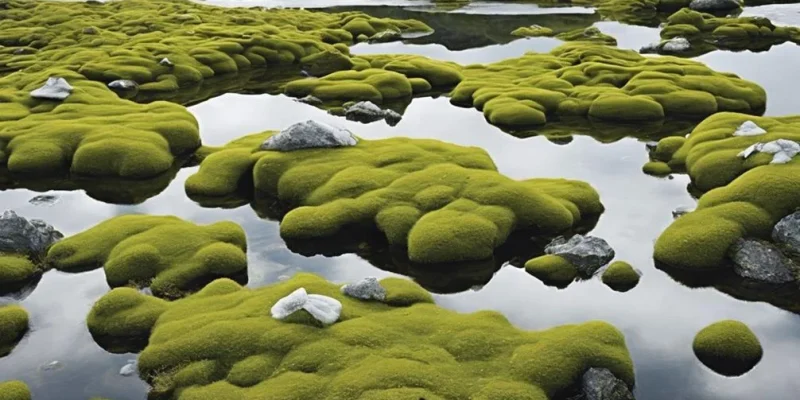Arctic Moss Plant: 10 Astonishing Facts You Didn’t Know

The Arctic is home to some of the most extreme weather conditions on Earth, yet many plant species have adapted to survive its freezing temperatures and harsh environment. One such resilient species is the Arctic Moss Plant, a fascinating aquatic and terrestrial moss that thrives in the tundra. This plant plays a crucial role in the Arctic ecosystem, providing habitat and sustenance for various organisms. In this article, we will uncover 10 astonishing facts about the Arctic Moss Plant that you probably didn’t know.
One of the Slowest Growing Plants on Earth
The Arctic Moss Plant grows at an incredibly slow rate due to the frigid temperatures and short growing seasons in the Arctic. On average, it adds just one centimeter per year, making it one of the slowest-growing plants in the world. This slow growth is an adaptation that allows it to conserve energy and survive in extreme conditions.
Can Live for Over 100 Years
Despite its slow growth, the Arctic Moss Plant has a remarkably long lifespan. Some moss plants have been found to be over 100 years old! This longevity allows them to persist through multiple generations of Arctic wildlife, playing an essential role in the ecosystem’s stability.
Thrives in Both Water and Land
Unlike most plants that specialize in either terrestrial or aquatic habitats, the Arctic Moss Plant can thrive in both. It commonly grows in shallow Arctic lakes, ponds, and wet tundra soils, making it a highly versatile plant. This adaptability helps it absorb nutrients efficiently and endure extreme conditions.
Stores Nutrients to Survive Harsh Winters
The Arctic winter is harsh, with temperatures dropping far below freezing. To survive, the Arctic Moss Plant has developed a unique ability to store nutrients during the short summer months. These stored nutrients allow the plant to endure long periods of dormancy when the environment becomes too hostile for active growth.
Absorbs and Retains Water Like a Sponge
Mosses are known for their ability to absorb and retain water, and the Arctic Moss Plant is no exception. Its spongy structure allows it to soak up moisture efficiently, which is crucial in an environment where water is often locked in ice. This water-retention ability helps maintain moisture levels in the surrounding soil, benefiting other plants and organisms.
Plays a Key Role in Carbon Storage
The Arctic Moss Plant acts as a natural carbon sink by absorbing and storing carbon dioxide from the atmosphere. This process helps mitigate climate change by reducing greenhouse gas levels. As Arctic temperatures rise, the role of moss in carbon storage becomes increasingly significant in regulating global climate patterns.
Provides Habitat for Small Organisms
Many small Arctic organisms rely on the Arctic Moss Plant for shelter and sustenance. Microorganisms, insects, and even small aquatic creatures use the moss as a habitat. This plant forms a crucial part of the Arctic food web, supporting biodiversity in an otherwise extreme environment.
Survives Extreme Cold Through Dormancy
To withstand the extreme cold, the Arctic Moss Plant enters a state of dormancy during the winter months. In this state, its metabolic processes slow down significantly, allowing it to conserve energy until conditions become favorable for growth again. This remarkable adaptation ensures its survival in one of the harshest environments on Earth.
Used in Scientific Research
Scientists study the Arctic Moss Plant to understand how plants adapt to extreme climates and how ecosystems respond to environmental changes. Its ability to survive in extreme cold makes it a valuable subject in research on climate change, plant biology, and Arctic ecosystems.
Indicates Environmental Changes
As a highly sensitive species, the Arctic Moss Plant serves as an indicator of environmental changes in the Arctic. Shifts in its growth patterns, distribution, or health can signal changes in temperature, precipitation, and pollution levels, providing valuable insights into the impacts of climate change.
Conclusion
The Arctic Moss Plant is a truly remarkable species that has adapted to one of the most unforgiving environments on Earth. From its ability to store nutrients and survive extreme cold to its role in carbon storage and scientific research, this plant plays a crucial part in maintaining the Arctic ecosystem. As climate change continues to affect the region, understanding and preserving the Arctic Moss Plant will become increasingly important.
FAQs
Q1. Where can this type of moss be found?
This moss thrives in Arctic tundra regions, particularly in wet environments such as lakes, ponds, and marshy soils.
Q2. How does this moss survive extreme cold?
It adapts by storing nutrients during warmer months, retaining moisture efficiently, and entering a dormant state during freezing temperatures.
Q3. What role does this moss play in the ecosystem?
It helps maintain soil moisture, provides shelter for small organisms, and acts as a natural carbon sink, reducing greenhouse gases.
Q4. How does climate change impact this moss?
Rising temperatures and changing precipitation patterns can alter its growth, affect its ability to store carbon, and disrupt Arctic biodiversity.
Q5. Why is this moss important for scientific research?
Researchers study it to understand plant survival in extreme climates, monitor environmental changes, and assess the impact of global warming.
Also read: Emperor Penguin Next to Human: 10 Heartwarming Moments You Won’t Believe











